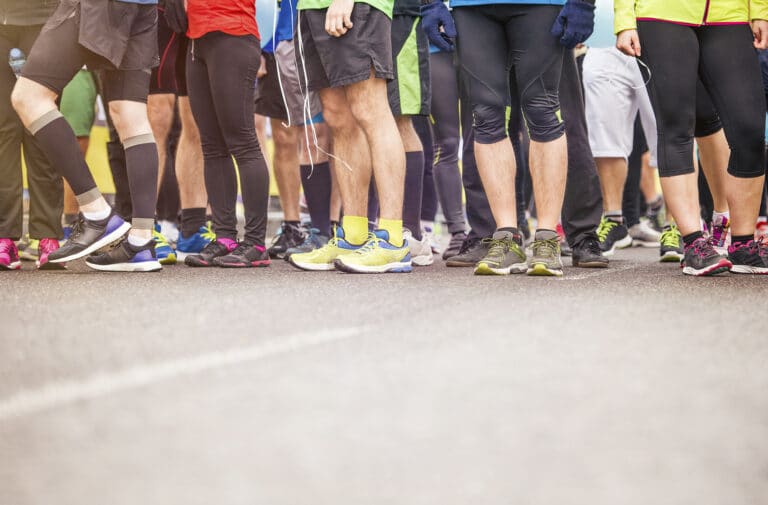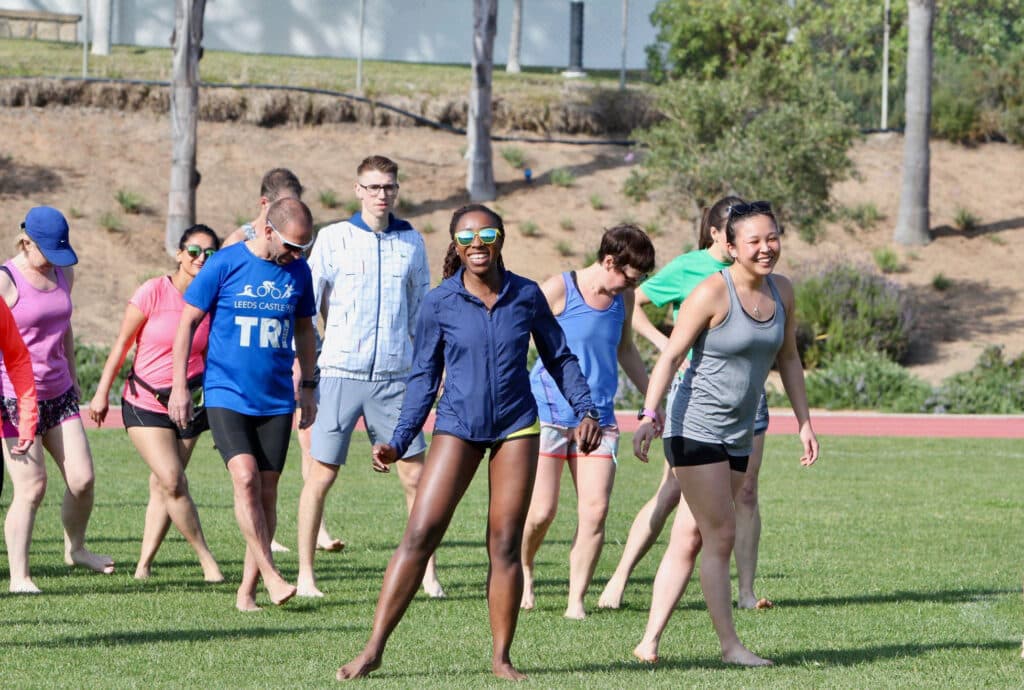


As a runner, you may have experienced those days when your legs feel tired and sore, making every step feel more laborious than usual. But do these tired legs actually cause you to run slower, or is it just a sensation you can power through? In this blog post, we’ll investigate the reasons behind muscle soreness, discuss whether you should run with sore legs, and share some tips on how to relieve sore legs from running – and how long it takes for you to bounce back.
Muscle soreness is a normal response to intense physical activity, such as running. It usually occurs after performing unfamiliar or strenuous exercises, which cause microscopic tears in your muscle fibres. These tiny tears then trigger an inflammatory reaction, resulting in the sensation of soreness and tightness in your muscles. There are many factors that can lead to sore legs after a run, such as:
This refers to the muscle pain and discomfort that typically arises 24-72 hours after engaging in a workout. It occurs as a result of small tears in the muscles caused by intense or novel exercises. This happens when you push beyond your body’s accustomed limits, leading to increased muscle breakdown and, consequently, longer recovery times. Soreness serves as a side effect of the repair process. DOMS can affect both novice and experienced runners, ranging from mild to debilitating. However, it is a normal part of increasing exercise intensity and should not be a cause for concern.
Increasing the intensity of your runs – whether it’s speed, distance, or incline, can result in muscle soreness as your body adapts to the increased demands. This soreness is caused by micro tears in the muscle tissue. For instance, after a challenging hill run, you’re likely to experience more soreness than usual. It’s also important to avoid increasing your mileage too quickly without taking a rest day, as this can lead to overuse injuries or additional soreness. Shin splints or stress fractures can occur if you are not careful.
Running with incorrect form can result in muscle imbalances and unnecessary strain on specific muscles and joints, leading to soreness and potential injury. When we fail to engage the correct muscles and overexert others, it places undue stress on our joints, tendons, and ligaments. Therefore, it is crucial to maintain proper form during any physical activity in order to prevent injuries.
It’s a common misconception that soreness and fatigue from previous runs will automatically hinder your performance. While it may feel like you’re running slower with sore legs, research suggests otherwise. A 2015 study published in the Journal of Strength and Conditioning Research found that muscle soreness did not affect runners’ speed or running economy (the amount of oxygen needed to maintain a certain pace) in a 5km time trial. However, it’s important to note that this was a small study and more research is needed to confirm these findings.
Running with tired legs is a common part of training, as it reflects the cumulative effect of increasing intensity and mileage over time. However, it is important to distinguish between running on tired legs and running on legs that are extremely sore. Whether or not you should run with sore legs depends on the severity of the pain and its underlying cause. If you are experiencing mild soreness due to DOMS (Delayed Onset Muscle Soreness) or a slight increase in intensity, you can still opt for an easy-paced run or engage in cross-training activities such as cycling or swimming. It is crucial to listen to your body and avoid pushing yourself too hard, as your muscles need sufficient time to recover and rebuild. However, if the soreness is severe, sharp, or persistent, it may indicate an injury. In such cases, it is advisable to rest, apply ice, and seek professional advice from a healthcare provider before resuming your running routine.
Fortunately, experiencing muscle soreness after a run is often a positive sign that your muscles are growing stronger as you adjust to longer distances. Here are some ways to speed up recovery and alleviate sore legs from running:
Always remember to warm up before any physical activity. Incorporate dynamic stretches into your warm-up routine to ensure that your muscles are not tight. Tight muscles are more susceptible to injuries and limit your range of movement. It is important to establish a regular stretching routine, focusing on major muscle groups such as the hamstrings, quadriceps, and calves. Consider incorporating regular yoga and pilates sessions before or after your workouts. Finally, don’t forget to cool down after your exercise session.
Foam rolling can help release muscle tightness and increase blood flow to your muscles. It improves blood flow in the area that is bothering you. This increase in blood flow helps bring oxygen and nutrients to your muscles, which can help speed up the healing process.
For immediate relief from sore legs, apply ice packs to reduce inflammation and numb the pain. Many athletes swear by an ice bath to aid recovery. Fill a tub with cold water and add ice cubes to create an icy bath. Spend 10-15 minutes in the ice bath for maximum benefits.
To maintain optimal muscle hydration, ensure you drink water before, during, and after your runs. Dehydration weakens muscles and increases the risk of injury, while also leading to muscle cramps. Begin your day with a generous glass of water, take regular sips throughout your run, and consider adding electrolyte powders for more intense or hotter workouts.
A valuable guideline is that if you experience such extreme soreness that it hampers your normal functioning, it is advisable to take a day or two of rest instead of risking further injury. It may be challenging to embrace a rest day and it may seem like you’re losing fitness, but a well-timed recovery day is crucial. Without them, you risk overtraining and becoming more susceptible to injuries. Rest days aid in our body’s recovery and overall well-being. Ensure that your training plan incorporates them effectively.

Instead of running every day, vary your workouts by incorporating low-impact cross-training activities like swimming and cycling. This approach can effectively reduce leg stress and mitigate the risk of overuse injuries. Additionally, include strength training exercises that specifically target the muscles used for running to enhance muscle endurance and improve overall balance.
A massage gun is an effective tool in alleviating muscle pain. It can be used to ease soreness in different muscle groups such as quads, calves, hamstrings, and glutes. Massage guns function by enhancing blood circulation to the targeted area, thereby reducing inflammation and facilitating the healing process.
The recovery time for sore legs varies depending on the severity of the muscle soreness and the individual. Generally, muscle soreness related to DOMS may take anywhere from 2 to 7 days to completely subside. However, if you’re recovering from an injury, the healing process will likely take longer and may necessitate medical intervention. If you’re experiencing pain that does not improve even after a few easy days or a day of rest, it’s important to consider that it may be a more serious issue. If you’re dealing with sharp or lingering pain, it might be wise to seek the guidance of a sports physiotherapist.
While running with sore legs may not necessarily slow you down, it is important to listen to your body and modify your training as needed. Incorporating the above strategies can help alleviate soreness and prevent injuries, allowing you to continue enjoying your runs without any hindrance. Remember that proper form, rest days, and cross-training are essential components of a well-rounded training plan.
Try incorporating pilates into your training regimen to strengthen your muscles, improve flexibility, and reduce the risk of future soreness and injury. Not only will pilates help prevent sore legs, but it will also aid in your overall running performance, making those extra miles feel easier and more enjoyable!
We highly recommend Pilates for Runners. Start your 7 day trial today!
Keep pushing yourself, but also listen to your body – Remember: rest is just as important as training!
Share this article
Running is one of the most common forms of exercise and physical activity. It requires...
Weight loss is a common goal for many runners, and deciding the ideal running frequency...
Running a marathon is an incredible athletic feat that many people aspire to achieve. However,...
Why do your training plans have the sessions in time rather than miles or KM?...
As a runner, you’re probably familiar with the importance of staying hydrated and fueling your...
Running is a popular form of exercise that can help you lose weight and improve...
We’re here to make sure you’re up-to-date with the latest running tips, events and product discounts – we’ve always got your back! Rest assured, we value your privacy and would never dream of selling your address.
BONUS: Sign up today and receive a FREE code for our Sub-4-Hour Marathon Plan